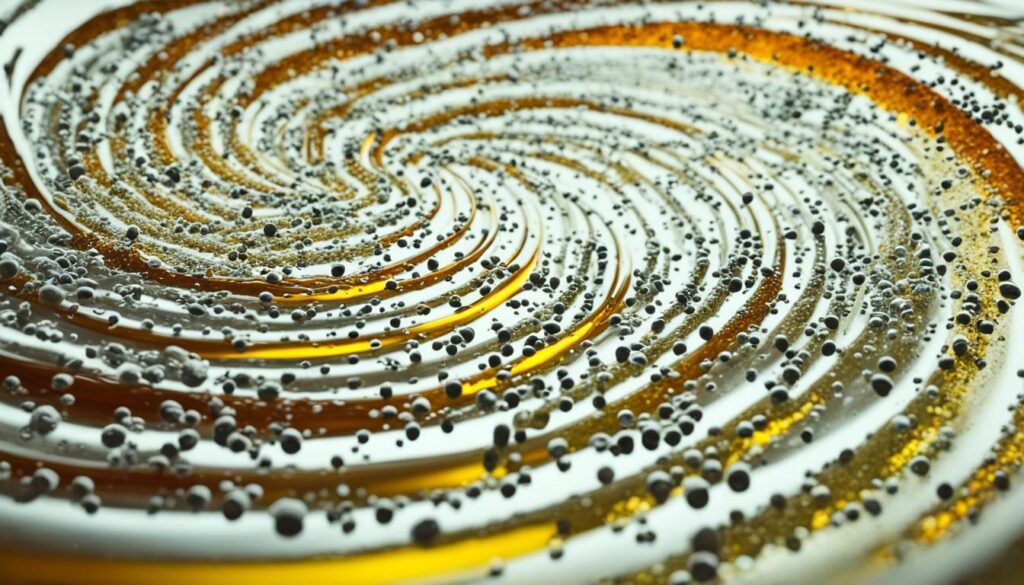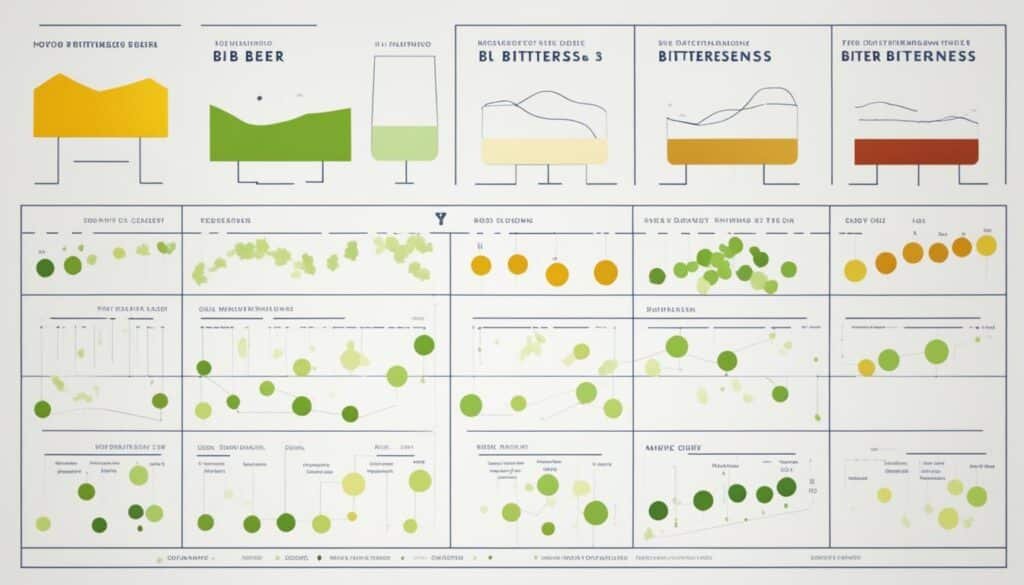The quest to discern what makes beer bitter leads aficionados and brewers down an intriguing path of discovery, exploring the myriad beer bitterness sources. Central to this journey is the understanding that the distinctive beer taste bitterness is not merely a consequence of happenstance but the result of meticulous crafting.
As an integral aspect of beer’s flavor profile, bitterness balances the malt’s inherent sweetness, framing the sensory experience of each sip. Unearthing the elements that contribute to this bitterness involves delving into the botanical role of hops, the chemistry of brewing, and the influences of additional ingredients. From the hop fields to the pint glass, every step uncovers more about what makes beer bitter and more complex than one might initially perceive.
Key Takeaways
- Hop-derived bitterness is the primary contributor to the beer’s bitter taste.
- The unique qualities of various hop varieties significantly shape a beer’s bitterness profile.
- Other ingredients, such as citrus zest or herbs, also play into beer’s overall bitterness.
- Brewing techniques impact the solubility and presence of bittering compounds.
- Understanding beer bitterness is essential for balancing flavors in brewing.
- Beer enthusiasts appreciate the complexity added to beer by the bitterness.
The Role of Hops in Creating Beer’s Bitter Flavor
When pondering what makes beer bitter?, hop bitterness in beer often springs to the forefront. This isn’t surprising given the pivotal role hops play in the flavor profile of this beloved beverage. However, the chemistry of bitterness in beer brewing extends far beyond a single ingredient, encompassing a symphony of factors that craft the quintessential taste shared by many beer varieties.
Understanding Hop Varieties and Bitterness
Each hop variety infuses its unique essence into beer, contributing to the overall beer brewing bitterness. It’s not just about intensity; the hop variety shapes the very quality of beer taste bitterness. The level and type of bitterness are inextricably linked to these feathered florals, from the brisk bite of an American IPA to the subtle twang in a British Ale. Recognizing the characteristics of different hops is key for discerning beer enthusiasts and meticulous crafters alike.
The Chemistry Behind Hop Bitterness: Alpha Acids Explained
The science behind beer’s bitterness is rooted in alpha acids, ubiquitous compounds within the lupulin glands of hop cones. Predominantly, there are three alpha acids: humulone, cohumulone, and adhumulone, each fostering hop bitterness in beer in its distinct fashion. In the alchemy of the brew kettle, these acids morph into their iso-alpha forms, becoming more soluble and pronounced. This complexity puzzles even seasoned brewers, challenging them to balance beer taste bitterness.
Brewing Techniques and Their Impact on Bitterness
Refined brewing techniques have forever altered the path from hops to the harbinger of bitterness. The nuanced process of adding hops, particularly late in the brew or post-boil, can influence the bittering compounds and thus the perception of beer brewing bitterness. The International Bitterness Unit, or IBU, is traditionally wielded to gauge bitterness, yet it does not consistently predict the beer’s sensory bitterness, propelling brewers to rely on human sensory analysis to fathom the bitterness profile of their beer.
| Alpha Acid | Characteristic | Impact on Bitterness |
|---|---|---|
| Humulone | Provides a smooth, refined bitterness | High levels equate to intense bitterness |
| Cohumulone | Associated with harsher, sharp bitterness | Low levels preferred for smoother beer profiles |
| Adhumulone | Least abundant, milder impact | Contributes less significantly to overall bitterness |
In learning how to reduce beer bitterness, it’s essential to consider these varying factors and metabolic transformations. Whether through hop variety selection, strategic brewing methodology, or chemistry savvy, mastering the balance of bitterness is both an art and a science that shapes each beer’s unique appeal.
What Makes Beer Bitter?
While the quest to understand beer taste bitterness can lead us down a hop-lined path, it’s essential to recognize the multidimensional aspects that craft the final bitter profile of a brew. The foundation of beer taste bitterness is often attributed to iso-alpha acids, which originate from the essential brewing ingredient of hops. These acids are transformed during the boiling phase of brewing, making them soluble and active in imparting that quintessential bitterness. However, the taste sensation experienced as bitterness in beer is more intricate than this single component.
When drinkers ponder what makes beer bitter, they may be surprised to find that other compounds work alongside iso-alpha acids to shape this taste sensation. For instance, polyphenols derived from malt and other adjuncts can contribute to the bitterness in a more subtle manner. Each beer’s unique blend of ingredients, process of hops addition, and even water chemistry, leads to variations in the bitterness intensity and quality that our palate detects.
| Component | Contribution to Beer Bitterness | Characteristics |
|---|---|---|
| Iso-alpha acids | Primary bitterness | Strong, direct bitterness |
| Polyphenols | Secondary bitterness | Mild, astringent bitterness |
| Water Chemistry | Modulates bitterness perception | Can enhance or suppress bitterness |
The multifaceted nature of bitterness in beer goes beyond a single ingredient or process; it is the symphony of brewing elements working together that answers what makes beer bitter?
Achieving the ideal balance of bitterness to counteract malt sweetness is a craft that brewers fine-tune. It’s a pivotal aspect that determines whether a beer is harmoniously robust or overwhelmingly bitter.
Navigating the complexity of beer taste bitterness is not just about the amount of hops used; it is about understanding the subtle interplay of all compounds contributing to the final perception of bitterness on the tongue.
Beyond Hops: Other Contributors to Beer Bitterness

While hops are commonly cited as the primary source of beer taste bitterness, other elements significantly influence the palate. Exploring these alternative beer bitterness sources lays the groundwork for a more nuanced appreciation of the breadth of flavors that can be found in each pint.
How Malt Roasting Influences Bitterness
The roasting process of malt bears resemblance to that of coffee, with dark malts surrendering a complex water-soluble compound that enlivens the beer with a robust bitter note. Far from being a straightforward enhancer, the intensity of bitterness from the malt can often eclipse that of the hops, adding dimension to the tasting experience.
The Effects of Beer Aging on Bitterness Flavor Profiles
Discussing beer aging is crucial when addressing the evolution of beer taste bitterness. Over time, iso-alpha acids undergo degradation, primarily when beer is exposed to oxygen, leading to a softening of bitter flavors as the beer matures. Contrary to intuition, the beer’s bittering potential may maintain stability due to the compensative rise of beta-oxidation products, despite the reduction in alpha acid content.
The Role of Water pH and Beer Taste Bitterness
It is often overlooked that the pH level of water can play a significant role in shaping the bitterness experienced in beer. Lower pH levels have been tied to a decreased perception of beer taste bitterness, demonstrating the less-discussed effects that the brewing environment and process conditions can have on the final bitterness of beer.
As breweries strive to calibrate the levels of bitterness in their brews, understanding these variables becomes instrumental. It raises the question: how to reduce beer bitterness if desired? Adjusting each of these factors offers brewers the dials to fine-tune the taste to desirable levels.
In conclusion, while the bitterness of beer may initially be attributed to hops, deeper exploration reveals a medley of factors at play. From malt roasting practices to the aging process and even the pH of brewing water, each component interacts to create the beer’s signature bitter tapestry. These insights are not only valuable for the brewing professional but also for the discerning beer enthusiast seeking to understand the thermal layers behind each sip.
Deconstructing the International Bitterness Unit (IBU)

The International Bitterness Unit (IBU) is the gauge by which beer brewing bitterness is often quantified, but its numbers only tell part of the story. In the quest to understand the complexity of beer’s bitter profile, it’s crucial to dissect both the science of measurement and the subtleties of human perception.
How IBUs are Measured and Misconceptions
The process for measuring IBU in beer relies on scientific procedures that may appear straightforward. Acidification of a beer sample followed by ultraviolet light absorption gives us an IBU value. Yet, this metric can be misleading as it does not encompass all bittering agents, particularly non-hop derived contributions, therefore it doesn’t fully reflect what your tastebuds perceive.
Perceived Bitterness vs. Measured IBUs
Although IBUs provide a measured bitterness level, the actual perceived bitterness can differ immensely. Variables such as other compounds contributing to IBU values, like those from dark malts or the oxidation of hop resins, skew the correlation between measurement and perception. Educated beer connoisseurs are aware of this discrepancy and often seek to reduce beer bitterness or enhance it, not by numbers alone, but through sensory experience.
The complexity of perceived bitterness vs. measured IBUs is an invitation to dig deeper into beer science. It’s a call to blend the art of brewing with the rigor of empirical assessment, ultimately leading to a truer understanding of what shapes the beer we love.
Conclusion
In traversing the complex landscape of beer flavor, we have delved into the rich tapestry of factors that contribute to beer taste bitterness. The cultivation of bitter beer flavors is not merely a singular journey with hops as the sole companion, but rather a symphony of elements. The robust presence of alpha acids and their transformation through the brewing process signify only the onset of bitterness. Indeed, the alchemy of brewing introduces a host of other beer bitterness sources such as the malt roast, water chemistry, and even the effects of time through aging.
The skillful brewmaster must navigate the interplay of these constituents to craft a beer that resonates with the desired sensory experience. It is a confluence of science and artistry, where each decision from ingredient selection to process execution can heighten or soften the final bitter note. Whether one seeks the peak of bitterness or a more subtle undertone, the mastery of these elements can lead to the creation of a brew that stands as a testament to the brewer’s intention and expertise.
Thus, in answer to the query that opened our discourse—”What makes beer bitter?”—we arrive at a conclusion befitting the nuanced nature of beer itself. It is a multifaceted composite of botanical, chemical, and temporal influences that unite in the glass before us. With this knowledge, not only can connoisseurs more deeply appreciate the virtues of their chosen pint, but brewers, too, can refine their alchemy to evoke the precise bitterness that defines the character of their artful libations.
FAQ
What primarily causes beer to taste bitter?
The primary source of bitterness in beer comes from hops, which are the flowers of the humulus lupulus plant. They contain alpha acids that contribute to the bitter flavor when transformed into iso-alpha acids during the brewing process.
Are there other factors besides hops that contribute to beer bitterness?
Yes, other factors include the roasting of malts, which can give beer a bitter flavor similar to that found in roasted coffee beans. Ingredients like fruits, herbs, or vegetables and the pH level of the water used in brewing can also affect bitterness. Additionally, the aging process of beer can alter bitterness over time.
How do different hop varieties affect the bitterness of beer?
Different hop varieties contain varying levels of alpha acids, such as humulone, cohumulone, and adhumulone, which influence the intensity and quality of the beer’s bitterness. Beers with lower cohumulone levels are typically perceived as having a smoother bitterness profile.
Can brewing techniques alter the bitterness of beer?
Yes, advanced brewing techniques, such as adding hops late in the brewing process or post-boil for aromatic purposes, can alter the matrix of bittering compounds in beer, which can affect both the actual taste and measured bitterness.
What is the International Bitterness Unit (IBU) and does it accurately reflect beer bitterness?
The International Bitterness Unit (IBU) is a measure of the bitterness of beer, as measured by acidifying a beer sample and taking an ultraviolet light reading. While it provides a numerical value, it doesn’t always accurately reflect the perceived bitterness, as it’s influenced by various compounds, not all of which are derived from hops.
Can the bitterness of beer change over time?
Yes, as beer ages, the bitterness can change due to the degradation of iso-alpha acids and the staling process. Exposure to oxygen can reduce bitterness, while the increase of beta-oxidation products can maintain some bittering potential despite the loss of alpha acids.
How does the water pH level used in brewing impact beer bitterness?
The pH level of the water can affect how bitterness is perceived in the final beer product. Typically, a lower pH can reduce the perception of bitterness, showcasing the impact of brewing conditions on the beer’s taste.
How can perceived bitterness differ from measured IBUs?
Perceived bitterness can differ from the IBUs due to non-hop-derived compounds that contribute to overall bitterness but may not align with the harshness or quality of bitterness perceived by human taste. This includes compounds from dark malt or oxidized hop resins and other alterations in hop products.
Can the bitterness of beer be reduced and how?
Yes, the bitterness in beer can be managed or reduced through various methods, such as altering the timing and amount of hop addition during the brewing process, selecting hop varieties with lower alpha acid levels, adjusting the pH and mineral content of the brewing water, and focusing on the balance between malt sweetness and hop bitterness.
